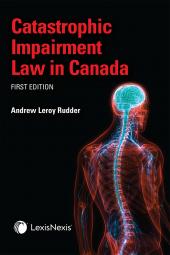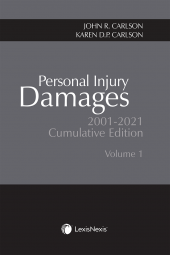Catastrophic Impairment Law in Canada
One Year Subscription Only Terms
Subscribers receive the product(s) listed on the Order Form and any Updates made available during the annual subscription period. Shipping and handling fees are not included in the annual price.
Subscribers are advised of the number of Updates that were made to the particular publication the prior year. The number of Updates may vary due to developments in the law and other publishing issues, but subscribers may use this as a rough estimate of future shipments. Subscribers may call Customer Support at 800-833-9844 for additional information.
Subscribers may cancel this subscription by: calling Customer Support at 800-833-9844; emailing customer.support@lexisnexis.com; or returning the invoice marked 'CANCEL'.
If subscribers cancel within 30 days after the product is ordered or received and return the product at their expense, then they will receive a full credit of the price for the annual subscription.
If subscribers cancel between 31 and 60 days after the invoice date and return the product at their expense, then they will receive a 5/6th credit of the price for the annual subscription. No credit will be given for cancellations more than 60 days after the invoice date. To receive any credit, subscriber must return all product(s) shipped during the year at their expense within the applicable cancellation period listed above.
Détails des produits
Drawing on his extensive experience representing clients who have suffered a catastrophic injury and are faced with exorbitant costs of recovery, in this new publication Catastrophic Impairment Law in Canada, lawyer and author Andrew L. Rudder undertakes a comprehensive examination of catastrophic impairment law in Canada, both on a provincial and a national level.
A Thorough Review
Unlike other titles in this practice area, Catastrophic Impairment Law in Canada is less of an assessment of personal injury damages and more of an analysis of how and why a certain assessment was given. In particular, Rudder explores:
- Ontario’s significant changes to the definition of “automatic catastrophic impairment” for children that came into effect on June 1, 2016
- The issue of discrimination based on geography, and the effect it has on children who are left with inadequate accident benefits coverage
- The differences between public and private auto insurance regimes, presented in an easy-to-read chart format
- The regimes currently in place in each province, including the administration, benefits and right to proceed with a tort lawsuit in each jurisdiction
- The inconsistencies in the auto insurance regimes throughout Canada and offers solutions that will ensure consistency across the country
This book will also appeal to lawyers and students who are interested in advocating for social justice. Because of inconsistent catastrophic impairment designations and discrimination based on geography, Rudder argues that the law as it currently stands has a disproportionately negative impact on marginalized members of society. He encourages readers to work on making the legal system better and more equitable. In short, this volume demonstrates how a lawyer’s role can extend beyond advocating for their client to include also advocating for the broader community and social justice issues.
Informative and Comprehensive
Catastrophic Impairment Law in Canada would be a useful acquisition for a range of readers, including:
- Civil litigation lawyers who will rely on it as a resource when dealing with personal injury matters
- Judges who will refer to it for guidance during trials
- Law students who want to learn about the different auto insurance regimes and catastrophic impairment laws across Canada
- Social justice advocates who are examining the effects of laws on marginalized members of society and are looking for ways to improve the legal system
Table des matières
Chapter 1: Introduction
PART I: Catastrophic impairment law in Ontario: Discriminatory ramifications based on geography in Ontario
Chapter 2: Ontario Regulation 251/15 Amendments to Ontario Regulation 34/10
Chapter 3: Paraplegia or tetraplegia: Permanent grade on the ASIA Impairment Scale
Chapter 4: Amputation and permanent loss: Spinal cord independence measure, version III
Chapter 5: Loss of vision of both eyes: The Snellen Chart or equivalent chart
Chapter 6: Adult brain injuries: Extended Glasgow Outcome Scale
Chapter 7: Whole person impairment, 55 per cent: AMA Guides, 4th edition
Chapter 8: Mental and behavioural disorder combined: AMA Guides, 6th and 4th editions
Chapter 9: Mental and behavioural disorder: AMA Guides, 4th edition
Chapter 10: Catastrophic impairment: Paediatric traumatic brain injuries
Chapter 11: The new automatic catastrophic impairment designation for children: Section 3.1(1)5i
Chapter 12: Inconsistent catastrophic impairment designations and discriminatory ramifications based on geography
Chapter 13: Legislative history: The evolution of section 3.1(1)5i of the SABS 34/10
Chapter 14: The rules governing the statutory interpretation of section 3.1(1)5i
Chapter 15: The application of the modern approach to statutory interpretation
Chapter 16: Amending section 3.1(1)5i of the SABS 34/10 and the Superintendent’s Guideline No. 01/16
PART II: A comparison analysis of the auto insurance regimes in Canada: Discriminatory ramifications based on province of residence
Chapter 17: Public versus private auto insurance regimes
Chapter 18: The exorbitant cost of raising a child with a catastrophic brain injury
Chapter 19: Ontario’s privately provided, no-fault-based auto insurance regime
Chapter 20: Alberta’s privately provided auto insurance regime
Chapter 21: New Brunswick’s privately provided auto insurance regime
Chapter 22: Nova Scotia’s privately provided auto insurance regime
Chapter 23: Prince Edward Island’s privately provided auto insurance regime
Chapter 24: Newfoundland and Labrador’s privately provided, liability-based auto insurance regime
Chapter 25: British Columbia’s publicly provided auto insurance regime
Chapter 26: Saskatchewan’s publicly provided, no-fault-based auto insurance regime
Chapter 27: Manitoba’s publicly provided, pure no-fault-based auto insurance regime
Chapter 28: Quebec’s publicly provided, pure no-fault-based auto insurance regime
Chapter 29: Northwest Territories’ auto insurance regime
Chapter 30: Nunavut’s auto insurance regime
Chapter 31: Yukon’s auto insurance regime
Chapter 32: Comparative analysis of the different auto insurance regimes
PART III: Lifetime care and support for catastrophically impaired insureds: Eliminating discrimination based on province of residence and disability
Chapter 33: Elements of an ideal auto insurance regime
Chapter 34: Lifetime care to catastrophically impaired insureds
Chapter 35: The infringement of the guaranteed right of equality
Chapter 36: The Charter remedy for an infringement of the guaranteed right of equality
Chapter 37: The appropriate section 24(1) remedy: Lifetime care and support schemes
Appendices
 Lexis Nexis
Lexis Nexis 


